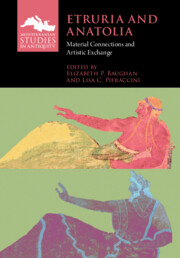Book contents
- Etruria and Anatolia
- Mediterranean Studies in Antiquity
- Etruria and Anatolia
- Copyright page
- Epigraph
- Contents
- Maps and Figures
- Contributors
- Preface
- Acknowledgments
- Notes on Abbreviations and Spelling
- Introduction
- Part I Broadening Perspectives
- Part II Interpretive Frameworks
- Part III Technology and Mobility
- Part IV Shared Practices
- Part V Shared and Distinct Iconographies
- Part VI Shared Forms, Distinct Functions
- 15 Forms and Functions of Beds and Couches in Etruscan and Anatolian Tombs
- 16 Female Assembly on Archaic Etruscan and Anatolian Funerary Monuments
- 17 Anatolian Fashion in Etruscan Clothing
- 18 Male Necklaces in the East and West
- Index
- References
17 - Anatolian Fashion in Etruscan Clothing
The Case of the Pointed Shoes
from Part VI - Shared Forms, Distinct Functions
Published online by Cambridge University Press: 02 March 2023
- Etruria and Anatolia
- Mediterranean Studies in Antiquity
- Etruria and Anatolia
- Copyright page
- Epigraph
- Contents
- Maps and Figures
- Contributors
- Preface
- Acknowledgments
- Notes on Abbreviations and Spelling
- Introduction
- Part I Broadening Perspectives
- Part II Interpretive Frameworks
- Part III Technology and Mobility
- Part IV Shared Practices
- Part V Shared and Distinct Iconographies
- Part VI Shared Forms, Distinct Functions
- 15 Forms and Functions of Beds and Couches in Etruscan and Anatolian Tombs
- 16 Female Assembly on Archaic Etruscan and Anatolian Funerary Monuments
- 17 Anatolian Fashion in Etruscan Clothing
- 18 Male Necklaces in the East and West
- Index
- References
Summary
Similarities in the imagery of Etruscan and Western Anatolian dress fashions, such as pointed shoes and Ionic chitons, indicate an obvious connection between the clothing systems of the two cultures. Indeed, Larissa Bonfante (2003) in her groundbreaking book Etruscan Dress classifies an “Ionian Phase” (550–475 BCE) in the development of the Etruscan clothing system. This chapter investigates the adaptation of Ionian dress items into the Etruscan dress repertoire through a comparative iconographic study of dress fashions in western Anatolia and Etruscan funerary art of the sixth and fifth centuries BCE. After an overview of prevailing dress fashions in both cultures, it explores the specific case of shoes with upturned toes (Etruscan/Hittite shoes, as they are commonly known) to show the changing meanings and cultural connections the adopted dress items conveyed.
- Type
- Chapter
- Information
- Etruria and AnatoliaMaterial Connections and Artistic Exchange, pp. 303 - 317Publisher: Cambridge University PressPrint publication year: 2023

